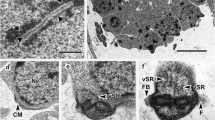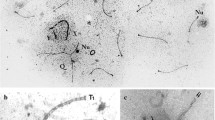Abstract
A method is presented for sequential analysis of the development and behaviour of the Synaptonemal Complex (SC) in primary spermatocytes of male mice, using agar filtration for electron microscope grid preparation. The mice were treated with hydroxyurea (HU) to produce a gap in the spermatogenic line. The front of surviving cells behind the gap was examined day by day. The first visible parts of unpaired axial elements, with some barely recognizable paired regions were found 9 days after the last HU injection i.e. directly after the last S-phase before meiosis. During mid zygotene and late zygotene the axes of the autosomes had a fuzzy ill-defined appearance with irregular regions of apparent thickening. The axes of the XY pair could be recognized only at late zygotene. During pachytene the SCs of the autosomal pairs did not show a significant change except for a slight increase in size of the attachment points of the axial elements. On the first day of pachytene the axes of the XY pair appeared thin and long. On the second day the axes of the XY pair showed maximal pairing of about 50% of the axis of the Y chromosome. From the third to the fifth day a decrease of the paired region of the sex chromosomes was found together with an increase in thickness of the axes, which reached its maximum on the fourth day. Diplotene could be easily recognized: the autosomal axes showed a sharp, well-defined outline with thick attachment points with deltoid structure, and desynapsis was very clear. The axes of the XY pair showed variation during diplotene but on the third day of diplotene a characteristic bulging could be seen. The axes of the autosomes disappeared at this time and in most cases only the attachment points remained visible.
The duration of the prophase classes of meiosis I was found to be: zygotene approximately 2 days; pachytene a little more than 5 days and diplotene approximately 3 days. Leptotene could not be traced by the method used. If it exists at all, it must be a stage of very short duration.
Similar content being viewed by others
References
Counce, S. J. & Meyer, G. F., 1973. Differentiation of the synaptonemal complex and the kinetochore in Locusta spermatocytes studied by whole mount electron microscopy. Chromosoma 44: 231–253.
Dietrich, A. J. J. & Mulder, R. J. P., 1981a. A light microscopic study of the development and behaviour of the synaptonemal complex in spermatocytes of the mouse. Chromosoma 83: 409–418.
Dietrich, A. J. J. & Mulder, R. J. P., 1981b. The staining of the synaptonemal complex for light microscopic study in the mouse. Stain Technol. 56: 163–167.
Dresser, M. E. & Moses, M. J., 1980. Synaptonemal complex karyotyping in spermatocytes of the Chinese hamster (Cricetulus griseus). IV. Light and electron microscopy of synapsis and nucleolar development by silver-staining. Chromosoma 76: 1–22.
Gillies, C. B., 1973. Ultrastructural analysis of mice pachytene karyotypes by three dimensional reconstruction of the synaptonemal complexes. Chromosoma 43: 145–176.
Grell, R. F., Oakberg, E. F. & Generoso, E. E., 1980. Synaptonemal complexes at premeiotic interphase in the mouse spermatocyte. Proc. natn. Acad. Sci. U.S.A. 77: 6720–6723.
Holm, P. B. & Rasmussen, S. W., 1977. Human meiosis I. The human pachytene karyotype analyzed by three dimensional reconstruction of the synaptonemal complex. Carlsberg Res. Commun. 42: 283–323.
Moens, P. B., 1969. The fine structure of meiotic chromosome polarization and pairing in Locusta migratoria spermatocytes. Chromosoma 28: 1–25.
Monesi, V., 1962. Autoradiographic study of DNA synthesis and the cell cycle in spermatogonia and spermatocytes of mouse testis using tritiated thymidine. J. Cell Biol. 14: 1–18.
Moses, M. J., 1977a. Synaptonemal complex karyotyping in spermatocytes of the Chinese hamster (Cricetulus griseus). I. Morphology of the autosomal complement in spread preparations. Chromosoma 60: 99–125.
Moses, M. J., 1977b. Synaptonemal complex karyotyping in spermatocytes of the Chinese hamster (Cricetulus griseus). I. Morphology of the XY pair in spread preparations. Chromosoma 60: 127–137.
Moses, M. J., Dresser, M. E. & Poorman, P. A., 1981. DNA synthesis associated with synaptonemal complexes in meiotic prophase. J. Cell Biol. 91: 70a.
Oakberg, E. F., 1956. A description of spermiogenesis in the mouse and its use in analysis of the cycle of the seminiferous epithelium and germ cell renewal. Am. J. Anat. 99: 391–413.
Oud, J. L., De Jong, J. H. & De Rooij, D. G., 1979. A sequential analysis of melosis in the male mouse using a restricted spermatocyte population obtained by a hydroxyurea/triaziquone treatment. Chromosoma 71: 237–248.
Oud, J. L. & Reutlinger, A. H. H., 1981. Chromosome behaviour during early meiotic prophase of mouse primary spermatocytes. Chromosoma 83: 395–407.
Sheridan, W. F. & Barrnett, R. J., 1969. Cytochemical studies on chromosome ultrastructure. J. Ultrastruct. Res. 27: 216–229.
Solari, A. J., 1970. The spatial relationship of X and Y chromosomes during meiotic prophase in mouse spermatocytes. Chromosoma 29: 217–236.
Solari, A. J., 1980. Synaptonemal complexes and associated structures in microspread human spermatocytes. Chromosoma 81: 315–337.
Tres, L. L., 1977. Extensive pairing of the XY bivalent in mouse spermatocytes as visualized by whole-mount electron microscopy. J. Cell Sci. 25: 1–15.
Tres, L. L., 1979. Side-by-side pairing of the XY bivalent in spermatocytes and the ubiquity of the H-Y locus. Arch. Androl. 2: 101–108.
Wettstein, R. & Sotelo, J. R., 1967. Electron microscope serial reconstruction of the spermatocyte I nuclei at pachytene. J. Microsc. 6: 557–576.
Woldringh, C. L., De Jong, M. A. Van den Berg, W. & Koppes, L., 1977. Morphological analysis of the division cycle of two Escherichia coli substrains during slow growth. J. Bact. 131: 270–279.
Author information
Authors and Affiliations
Rights and permissions
About this article
Cite this article
Dietrich, A.J.J., De Boer, P. A sequential analysis of the development of the synaptonemal complex in spermatocytes of the mouse by electron microscopy using hydroxyurea and agar filtration. Genetica 61, 119–129 (1983). https://doi.org/10.1007/BF00123222
Received:
Accepted:
Issue Date:
DOI: https://doi.org/10.1007/BF00123222




